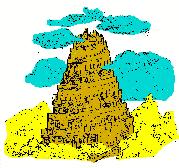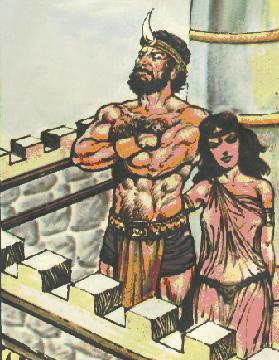"Tongues"
1. "Shan Dalah": "Loose tooth".
2. "Hamahnah": "Hum"; "Loud noise of a multitude".
3. "Habel-ah": "Empty"; "Vain".
4. "Shammah": "Desolate"; "Waste".
5. "Shesh": "Make Mirth"; "Cheerful".
Interestingly, these are all Hebrew in origin, and are commonly uttered by many "tongues" talkers; usually in no particular order or context.
Although there is definitely a genuine phenomenon of "tongues", we must be cautious not to find ourselves counted among the " ... wizards who whisper and mutter, ..." (Is. 8:19) (See also: Is. 29:13 "lip-service"; "tradition learned by rote")

The earliest known written records are Sumerian cuneiform, which appeared thousands of years after spoken language; circa 3100 B.C. Cuneiform tablets written in 3000 B.C. were found at Uruk near the mouth of the Euphrates. Uruk is near Ur, the ancient home of Abram. Both of these cities, as well as Babel, were founded by Nimrod, the "... mighty hunter before the Lord" (Gen. 10:9). Nimrod became the first king, and was the architect of the tower "...whose top will reach into heaven." (Gen. 11:4) Of course, God had other plans. Those who remained in Babel after the Confusion of the languages came under the rule of Nimrod and his mother/wife Semiramis, probably the most evil couple who ever lived. Together they founded the Political and Religious system known as "Mystery, Babylon the Great". That ancient Satanic sytem still holds sway to this day throughout the world, in one form or another. (1Jn. 5:19; Rev. 12:9) Before her death, Semiramis decreed Nimrod a "god" of heaven (Baal); and herself the supreme "goddess"; "Queen of Heaven", and "Mother of God".

Among the city-states of Sumer, Babylon did not become important again for another thirteen hundred years, during the reign of Hammurabi. In the eighth century B.C. Babylon fell to the Chaldeans, and was destroyed.
Egyptian pictographic heiroglyphics first appeared about 3000 B.C.
Sanskrit and Chinese appeared circa 2000 B.C.
In prehistoric times, the ancestors of the Vedic peoples migrated into India from the northwest, bringing with them the Aryan language. This tongue was only one step removed from the primordial language of Babel. (Indo-European)
The Aryan language is called "Proto-Indo-Iranian Persian"
The Semites worked out an alphabetical system of writing using variants of Egyptian structure (but not the same signs) beginning about 1500 B.C. The oldest examples of Semitic alphabetical writing were found, interestingly, near Mount Sinai!
The Greek Alphabet appeared as a variant of the Semitic about 1400 B.C.
Ancient Hebrew linguists were pioneers in Etymology (the science of word origins). Comparative linguists of the 18th century A.D. found in India amazing resemblances between Hindustani, Latin, Greek, and Hebrew. In the Rig Veda, circa 1000 B.C., are found Sanskrit words very similar to English: "Mata" - "Mother"; "Svasr" - "Sister"; "Bhrata" - "Brother"; "Sunu" - "Son"; "Duhita" - "Daughter"; "Manu" - "Man". Other words are similar to Hebrew: "Bhrama" - "Abraham" (Father); "Om" - "Amen" (So shall it be); "Krishna" - "Chrism"; "Shiva" - "Cheva" - "Yahshvah", etc. By further study, scholars found that almost all European, Persian, Afghani, and Northern Indian languages developed from one parent tongue, dubbed "Indo-European". No records of this language (undoubtedly the universal language of Genesis 11:1) exist. Much of it has, however, been reconstructed through modern scholorship in Etymology.
The Latin Alphabet arose as a variant of the Greek, circa 500 B.C.
The Andean Indian civilizations arose in the 5th century A.D. The Maya peaked around 700 A.D. They worshipped Kulkulcan, the winged serpent god, and Ixchel, the moon/fertility goddess who was bride of the sun. She was often pictured with one of her many consorts: a grinning rabbit! ("Bugs"? The "Playboy" and "Easter" bunny?) The Inca peaked around 1400 A.D. The Aztecs worshipped the winged serpent god Quetzalcoatl. They were conquered by Cortez in 1500 A.D. Many American Indian languages, customs, and religious practices are also remarkably similar to those of the ancient Mesopotamian cultures. Their heritage obviously traces back to Babel also, as do the the histories of all the civilizations of the world.